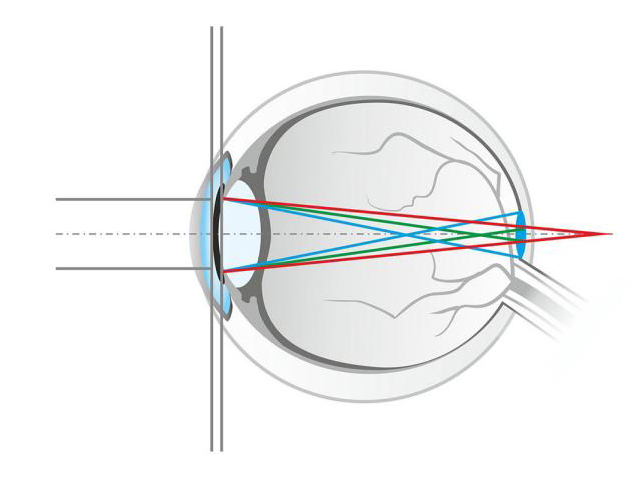
Blue light: the good and the bad
How much blue light do we need? And how and when should we be protecting ourselves against it?
A debate is raging over the beneficial and the damaging effects of blue light. On the one hand, blue light can be a helpful tool in combating winter depression and insomnia. On the other hand, blue light can permanently damage the human eye. So what's the deal with blue light? And what has changed about the artificial light we experience every day? Why do our bodies need the biological effects of this wavelength? And how and when should we protect ourselves from the potentially damaging effects of blue light? Read on to find out more about the good and the bad of blue light.
The visible spectrum
The light that reaches and enters the human eye is divided into visible light, comprising wavelengths from 380 to 780 nm, and non-visible light, which includes light in the ultraviolet range (UV light) and the infrared range (IR light).
Experts have been aware for some time that UV light can potentially damage biological tissue, such as our skin and eyes. That is why people typically take precautions to protect themselves from the sun, using items such as sun cream or a pair of sunglasses. However, visible blue-violet light also has the potential to cause damage to our eyes. Although blue-violet light has less energy than ultraviolet light, it is almost entirely unfiltered as it passes through the eye and reaches the retina. By way of contrast, ultraviolet light is almost entirely absorbed by the front part of the eye, and significantly less than 5% of it reaches as far as the retina.
The blue component of light between 380 and 500 nm is also known as high-energy visible (HEV) light. In particular blue-violet wavelengths between 380 and 440 nm are seen as potentially damaging and have been implicated as one of the possible causes of photoretinitis, i.e. damage to the retina caused by high-energy incident light.

Beneficial aspects of blue light
Light does more than just help us see, it is also an important means of regulating our biological rhythms and affects our general well-being. Light influences whether or not we are awake, focused and productive and feel energized and healthy.
Scientific studies have confirmed the biological effect of light on our body. Ultraviolet light, for example, influences the production of vitamins. Exposure to bright light and, in particular, the portion of blue light affects our hormonal balance. Hormones in the body regulate how a person feels as well as their sleep-wake cycle. In daylight, the portion of blue light is relatively high, whereas it is significantly reduced in the evening.
When it's bright outside, the body releases serotonin – also known as one of the "happy hormones" – and cortisol, a stress hormone. Both of these make us feel awake and active. However, melatonin is considered a sleep hormone and causes us to feel tired and sleep soundly when it is dark.
Light, in particular blue light that reaches the retina, also affects our psychological well-being. That is why light therapy is successfully employed to treat winter depression and insomnia. But, as is so often the case, the axiom "everything in moderation" still applies. Exposure to too much light also carries certain risks and can even be damaging.
Damaging effects of blue light
Too much light in the ultraviolet and blue-violet bands can damage the human eye. As well as leading to painful inflammation of the conjunctiva and cornea, it can also cause damage to the eye's crystalline lens (e.g. cataracts) and especially to the retina (macular degeneration).
That's why it is so important to wear sunglasses with 100% UV protection in strong sunshine, especially in situations where there is a lot of glare such as on water or snowy mountain slopes.
The modern world: light sources with a high proportion of blue light
From light-emitting diodes (LEDs) and xenon light to energy-saving bulbs and electromagnetic radiation from screens, all the "new ligh t sources" that are designed to make our lives better and easier contain a higher proportion of blue light than the old traditional light bulbs. The different spectral composition of the light means that we are exposed to significantly more blue light than before. Could this be having a detrimental effect on our eyesight?
A recent paper suggests that the effects of blue light are counteracted if you have been exposed to even relatively dim light during the day. “You might get 500 lumens from an e-reader, but even a cloudy day in the UK is going to be 10,000 lumens or more,” says Foster. “So it seems as if normal light exposure by the environment is going to mitigate any subtle impacts at dusk or before bedtime.”
In other words, it is unlikely you are setting yourself up for serious health problems by occasionally flipping through an e-reader or going on a streaming bender before bed. You might experience eye strain from staring at a screen for too long – or stress yourself out by checking late-night emails – but your sleep is unlikely to suffer.
Our tip: We recommend giving your eyes more frequent breaks by looking into the distance much more often – even when you are in the middle of working on your laptop, tablet or smartphone. And make sure your eyes are exposed to enough brightness while ensuring they are adequately protected against excessive UV and and blue-violet light.